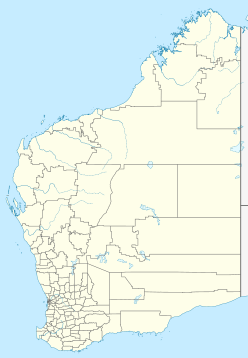Bedout facts for kids
| Impact crater/structure | |
|---|---|
| Confidence | Possible |
| Diameter | 30 km (19 mi) |
| Age | 250.1 ± 4.5 Ma Permian-Triassic boundary |
| Exposed | No |
| Drilled | Yes |
| Location | |
| Location | Canning Basin |
| Coordinates | 18°S 119°E / 18°S 119°E |
| Country | |
| State | Indian Ocean |
Bedout, also called the Bedout High, is a unique geological area hidden deep under the ocean. It is located about 250 kilometers (155 miles) off the northwestern coast of Australia. This area is part of the Canning Basin and Roebuck Basin.
Even though you can't see it from the sea surface, Bedout is a roughly circular spot. It is about 30 kilometers (19 miles) wide. In this area, very old rocks have been pushed up by as much as 4 kilometers (2.5 miles). Scientists think Bedout might be the center of a very large, buried impact crater. This giant crater could be up to 250 kilometers (155 miles) across.
In the 1970s and 1980s, two oil exploration wells, Bedout-1 and Lagrange-1, drilled into the Bedout High. The area is named after the nearby Bedout Island.
Contents
Could Bedout Be a Giant Impact Crater?
The Impact Idea
In 1996, an Australian geologist named John Gorter first suggested that Bedout High might be a huge, buried impact crater. He thought it could be as wide as 250 kilometers (155 miles). His idea was based on the internal structure of the rocks, seen in a special underground scan called a seismic survey. He also thought it was formed around the end of the Permian period. This was based on the age of volcanic rocks found in the Lagrange-1 well.
Later, Luanne Becker and her team from the University of California looked into this idea more. They believed the rocks in the wells, which were thought to be volcanic, were actually "impact melt breccia". This is a type of rock formed when a large object hits the Earth. They claimed these rocks showed signs of "shock metamorphism," which means they were changed by a powerful impact.
Connecting Bedout to a Mass Extinction
Becker's team re-dated these rocks to be about 250.1 million years old. This age is very close to the time of the Permian–Triassic boundary. This period is famous for the Permian-Triassic extinction event. This was the largest mass extinction in Earth's history. Becker thought there might be a link between the Bedout impact and this huge extinction.
Further studies, based on early data, suggested that the presence of chromium isotopes could support the impact idea. These isotopes might show that material from space was present.
Why Some Scientists Doubt the Impact Idea
Arguments Against the Impact Hypothesis
Many experts who study impact craters do not widely support the Bedout impact idea. They have several reasons why they disagree:
- Not Impact Rocks: They say the rocks thought to be "impact melt breccia" actually look like regular volcanic basalt. They believe any changes to these rocks are due to contact with seawater or deep burial, not an impact. They also think the signs of shock metamorphism were likely mistaken.
- Missing Debris: If such a huge crater was formed, it should have spread a wide layer of rock and dust (called "ejecta") across the Earth. However, no such ejecta has been found at nearby sites from the Permian-Triassic boundary in Australia.
- Flawed Evidence: Some critics argue that the evidence presented for the impact does not meet the usual scientific standards. They also believe the methods used to date the rocks were not accurate.
- Geophysical Data: A detailed review of the underground data suggests that the Bedout High does not look like a giant impact crater. Instead, it seems more likely that the Bedout High was formed by different periods of "continental rifting." This is when the Earth's crust pulls apart.


